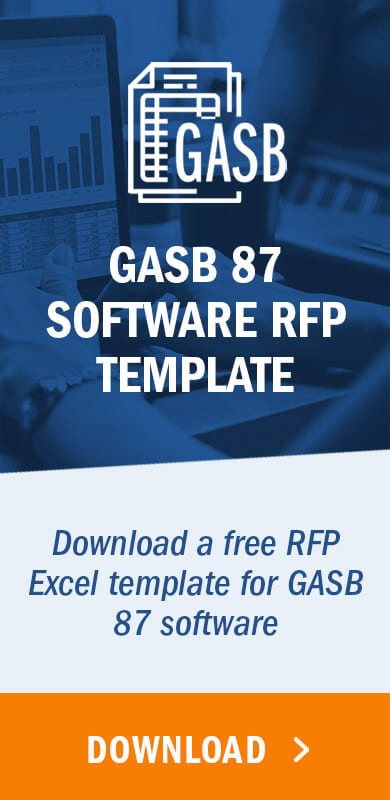2. What types of organizations report under GASB?
3. Government accounting standards
- GASB 87: Lease accounting
- GASB 94: Accounting for public-private and public-public partnership arrangements
- GASB 96: Accounting for subscription-based IT arrangements
5. Other common GASB statements
GASB explained
GASB, which stands for Governmental Accounting Standards Board, is the group that sets the accounting and financial standards for state and local government entities in the United States. Established in 1984, the members of GASB are appointed by the trustees of the Financial Accounting Foundation (FAF). Like the Financial Accounting Standards Board (FASB), GASB is an independent, nongovernmental organization.
What types of organizations report under GASB?
Local and state government entities following US GAAP report under GASB. That includes municipalities, public employee retirement systems, and utilities. Public benefit corporations – a type of for-profit entity that includes specific public benefits in its statement of purpose – also report under GASB. GASB applies to government-operated hospitals and healthcare providers as well.
Government accounting standards
The fund accounting principles underlying GASB provide transparency around an entity’s use of its funding and resources. Therefore, state and local governments are not the only governmental entities that need to record and manage their financial transactions to provide transparency and accountability to the public.
Government accounting standards apply to federal entities as well as state and local entities. Federal agencies report under the Federal Accounting Standards Advisory Board, or FASAB, the body that regulates generally accepted accounting principles (GAAP) for the federal government. GASB on the other hand, provides accounting guidance for local and state government agencies. A full list of GASB statements is included later in this article.
New governmental accounting standards you should know
In the last few years, GASB has released several new statements to clarify ambiguous guidance and accommodate the evolving nature of government operations. Here’s an overview of three of the most talked-about new standards:
- GASB 87, addressing leases
- GASB 94, accounting and disclosure guidance for public-private and public-public partnership arrangements
- GASB 96, covering the accounting treatment for Subscription-Based Information Technology Arrangements (SBITA)
GASB 87: Lease accounting
On the heels of new lease accounting standards for private and non-profit organizations, GASB released Statement No. 87, Leases. It supersedes the guidance provided by GASB 62 and GASB 13. The standard was initially set to go into effect for all reporting periods beginning after December 15, 2019. However, the effective date was delayed due to the COVID-19 global pandemic, and it’s now scheduled for fiscal years beginning after June 15, 2021. Despite the timeline shift, organizations still must restate all prior periods presented if practicable and it is advised to not delay the transition to the new standard.
GASB 87 departs from GASB 62 in several significant ways. For starters, leases are no longer classified as either capital or operating. Instead, all leases are classified as finance leases. Additionally, an exception for short-term leases now exists. Leases with a maximum possible term of 12 months or less are not required to be reported under the new standard. Under GASB 62, short-term leases were not specifically excluded.
GASB 87 lessor accounting also mirrors lessee accounting. Lessors are now required to record a lease receivable and deferred inflow of resources on the balance sheet and recognize the income over the term of the lease.
GASB vs. FASB lease accounting
As mentioned, GASB 87 was released shortly after the FASB released ASC 842, Leases, for corporations and non-profit organizations reporting under US GAAP. Despite the similarity in timing, however, the GASB guidance doesn’t completely mirror that of the FASB. In fact, quite a few notable differences can be found.
First, the definition of a lease is different. Under GASB 87, an “exchange or exchange-like transaction” is required to determine if a contract contains a lease, whereas ASC 842 language states an “exchange for consideration” must occur. A contract qualifying as a lease under ASC 842 may not qualify under GASB.
Another key difference is in the assessment of control. Under ASC 842, substitution rights can impact the determination of control. If a lessor has the right to substitute an asset and benefits economically from the substitution, then they have a substantive substitution right and the agreement does not constitute a lease. Under GASB 87, such substitution rights have no impact on the determination of control.
Read full examples of GASB 87 lease accounting:
GASB 94: Accounting for public-private and public-public partnership arrangements
GASB 94 establishes new accounting and disclosure guidance for public-private and public-public partnership arrangements (referred to as PPP or P3). This new standard supersedes GASB Statement 60 and is effective for fiscal years beginning after June 15, 2022, the same as GASB 96. A government (the transferor) contracts a third party (the operator) to provide public services by conveying control of the right to operate/use a nonfinancial asset for a period of time.
GASB 94 vs. GASB 87
Some of the accounting rules under GASB 94 and GASB 87 are almost identical including discount rates, measurement of contract length, analysis of modifications/terminations. Underlying accounting mechanics are similar for the initial and subsequent measurement of liability and right-of-use assets. The primary difference between GASB 94 and GASB 87 is that P3 arrangements can include the construction/purchase of a new asset that must be accounted for by both the transferor and the operator.
GASB 96: Accounting for subscription-based IT arrangements
GASB Statement No. 96, Subscription-Based Information Technology Arrangements (GASB 96), addresses the accounting for software subscription services. As cloud-based software usage becomes more popular, accounting professionals need more prescriptive guidance on how to assess subscription-based IT arrangements (SBITA) and how to present them on their financial statements.
Under GASB 96, the determination of a SBITA depends heavily on the assessment of control – whether the government is granted rights to the present service capacity of the underlying IT assets and to dictate the nature and manner of use of the underlying IT assets. Exemptions include:
- Contracts meeting the definition of a lease under GASB 87
- Contracts falling under the scope of GASB Statement No. 51, Accounting and Financial Reporting for Intangible Assets (GASB 51)
One of the key topic areas covered by GASB 51 is the development of computer software. However, its focus is on internally developed software paid for through perpetual licensing agreements, which are structured differently from SBITAs and require a different set of financial obligations.
Scheduled to be effective for fiscal years beginning after June 15, 2022, GASB 96 requires organizations to recognize a subscription liability and a subscription asset at the commencement of the subscription term of the SBITA. The subscription term begins when the government entity obtains control of the right to use the underlying IT asset. Download the Ultimate GASB 96 Guide to learn more.
Read a full example of GASB 96 accounting and an overview of the new standard:
Other common GASB statements
Over the last three and a half decades, GASB has released several landmark statements widely impacting government accounting. Below, we’ve summarized some of the most well-known and frequently-searched governmental accounting standards.
GASB 34
When GASB Statement No. 34, Basic Financial Statements—and Management’s Discussion and Analysis—for State and Local Governments (GASB 34), was released, it was considered the most sweeping innovation in governmental accounting and financial reporting. It expanded on the existing guidance to make financial statements more useful for a wider range of users by updating the fund reporting requirements and adding new information .
One of its most notable changes was the introduction of a required management’s discussion and analysis (MD&A) section. MD&A allows stakeholders to better assess whether an agency’s financial position has improved or declined in the reporting year.
GASB 34 also requires annual reports to use accrual accounting to report all government spending, requiring the conversion of any modified accrual basis governmental funds to full accrual. When it was issued in 1999, it was the first time government entities were required to report long-term assets and liabilities, as well as all revenues and all costs related to providing services each year.
GASB 62
GASB Statement No. 62, Codification of Accounting and Financial Reporting Guidance Contained in Pre-November 30, 1989 FASB and AICPA Pronouncements (GASB 62), provides broad guidance that simplifies and brings consistency to accounting research and application. Issued in late 2010, the scope of GASB 62 includes more than 30 reporting areas, such as leases, contingencies, the capitalization of interest costs, and more.
GASB 62 superseded GASB Statement No. 20, which allowed for enterprise funds and business-type activities to apply FASB Statements and Interpretations issued after November 30, 1989, as long as they aren’t in conflict with previous GASB pronouncements. This approach created inconsistency in interpretation and unnecessarily complicated research. GASB 62 provides authoritative guidance on many of the topics covered in Statement No. 20 while also making accommodations for the specific needs of government financial reporting.
Some of GASB 62’s significant requirements for leases include:
- Two classifications, capital and operating leases
- A single treatment for all short-term leases
For lessors, operating leases could only be recorded as recognition of income when payments came due. Those rules are now superseded by GASB 87, which we’ll cover more in-depth later.
GASB 75
GASB Statement No. 75, Accounting and Financial Reporting for Postemployment Benefits Other Than Pensions (GASB 75), went into effect for fiscal years beginning after June 15, 2017. This statement focuses on healthcare, life insurance, and other post-employment benefits (OPEB) plans. New guidance under GASB 75 updates the analysis and disclosures required by OPEB plan actuaries. Additional requirements affecting government entities themselves are also included. Among them are:
- Valuations to be completed every two years for all benefit plans
- Reporting the unfunded OPEB liability on the statement of net position
- Disclosing deferred inflows/outflows as a result of changing past actuarial assumptions
Prior to the issuance of GASB 75, governments with single-employer or agent multiple-employer OPEB plans were only required to disclose their net OPEB liability in the notes to their financial statements. Governments with cost-sharing, multiple-employer OPEB plans, and special-funding plan types weren’t required to disclose their net OPEB liability at all.
GASB 84
GASB Statement No. 84, Fiduciary Activities (GASB 84), refines the definition of fiduciary funds and outlines their treatment in financial statements. The goals of GASB 84 are:
- Properly identify fiduciary activities
- Consistently determine the type of fund used to report on each activity
- Appropriately present fiduciary activities in financial statements
It went into effect for reporting periods starting after December 15, 2019, and clarified ambiguities in the previous guidance. Prior to the issuance of GASB 84, no guidance for differentiating fiduciary activities existed, including fiduciary component units, leading to inconsistent interpretation and application.
GASB statements: A complete list
Below you’ll find a list of all the statements of governmental accounting standards issued by the GASB along with the corresponding issuance dates, ordered from newest to oldest. We’ve included notes for GASB standards that have been fully superseded by others as well.
- GASB 98, The Annual Comprehensive Financial Report. Issued in October 2021.
- GASB 97, Certain Component Unit Criteria, and Accounting and Financial Reporting for Internal Revenue Code Section 457 Deferred Compensation Plans—an amendment of GASB Statements No. 14 and No. 84, and a supersession of GASB Statement No. 32. Issued in June 2020.
- GASB 96, Subscription-Based Information Technology Arrangements. Issued in May 2020.
- GASB 95, Postponement of the Effective Dates of Certain Authoritative Guidance. Issued in May 2020.
- GASB 94, Public-Private and Public-Public Partnerships and Availability Payment Arrangements. Issued in March 2020.
- GASB 93, Replacement of Interbank Offered Rates. Issued in March 2020.
- GASB 92, Omnibus 2020. Issued in January 2020.
- GASB 91, Conduit Debt Obligations. Issued in May 2019.
- GASB 90, Majority Equity Interests—an amendment of GASB Statements No. 14 and No. 61. Issued in August 2018.
- GASB 89, Accounting for Interest Cost Incurred before the End of a Construction Period. Issued in June 2018.
- GASB 88, Certain Disclosures Related to Debt, including Direct Borrowings and Direct Placements. Issued in April 2018.
- GASB 87, Leases. Issued in June 2017.
- GASB 86, Certain Debt Extinguishment Issues. Issued in May 2017.
- GASB 85, Omnibus 2017. Issued in March 2017.
- GASB 84, Fiduciary Activities. Issued in January, 2017.
- GASB 83, Certain Asset Retirement Obligations. Issued in November, 2016.
- GASB 82, Pension Issues—an amendment of GASB Statements No. 67, No. 68, and No. 73. Issued in March, 2016.
- GASB 81, Irrevocable Split-Interest Agreements. Issued in March 2016.
- GASB 80, Blending Requirements for Certain Component Units—an amendment of GASB Statement No. 14. Issued in January 2016.
- GASB 79, Certain External Investment Pools and Pool Participants. Issued in December 2015.
- GASB 78, Pensions Provided through Certain Multiple-Employer Defined Benefit Pension Plans. Issued in December 2015.
- GASB 77, Tax Abatement Disclosures. Issued in August 2015.
- GASB 76, The Hierarchy of Generally Accepted Accounting Principles for State and Local Governments. Issued in June 2015.
- GASB 75, Accounting and Financial Reporting for Postemployment Benefits Other Than Pensions. Issued in June, 2015.
- GASB 74, Financial Reporting for Postemployment Benefit Plans Other Than Pension Plans. Issued in June, 2015.
- GASB 73, Accounting and Financial Reporting for Pensions and Related Assets That Are Not within the Scope of GASB Statement 68, and Amendments to Certain Provisions of GASB Statements 67 and 68. Issued in June, 2015.
- GASB 72, Fair Value Measurement and Application. Issued in February, 2015.
- GASB 71, Pension Transition for Contributions Made Subsequent to the Measurement Date—an amendment of GASB Statement No. 68. Issued in November, 2013.
- GASB 70, Accounting and Financial Reporting for Nonexchange Financial Guarantees. Issued in April, 2013.
- GASB 69, Government Combinations and Disposals of Government Operations. Issued in January, 2013.
- GASB 68, Accounting and Financial Reporting for Pensions—an amendment of GASB Statement No. 27. Issued in June, 2012.
- GASB 67, Financial Reporting for Pension Plans—an amendment of GASB Statement No. 25. Issued in June 2012.
- GASB 66, Technical Corrections—2012—an amendment of GASB Statements No. 10 and No. 62. Issued in March 2012.
- GASB 65, Items Previously Reported as Assets and Liabilities. Issued in March 2012.
- GASB 64, Derivative Instruments: Application of Hedge Accounting Termination Provisions—an amendment of GASB 53. Issued in June 2011.
- GASB 63, Financial Reporting of Deferred Outflows of Resources, Deferred Inflows of Resources, and Net Position. Issued in June 2011.
- GASB 62, Codification of Accounting and Financial Reporting Guidance Contained in Pre-November 30, 1989 FASB and AICPA Pronouncements. Issued in December 2010.
- GASB 61, The Financial Reporting Entity: Omnibus—an amendment of GASB Statements No. 14 and No. 34. Issued in November 2010.
- GASB 60, Accounting and Financial Reporting for Service Concession Arrangements. Issued in November 2010. Will be superseded by GASB 94 as of June 15, 2022.
- GASB 59, Financial Instruments Omnibus. Issued in June 2010.
- GASB 58, Accounting and Financial Reporting for Chapter 9 Bankruptcies. Issued in December 2009.
- GASB 57, OPEB Measurements by Agent Employers and Agent Multiple-Employer Plans. Issued in December 2009 and superseded by GASB Statements No. 74 and 75.
- GASB 56, Codification of Accounting and Financial Reporting Guidance Contained in the AICPA Statements on Auditing Standards. Issued in March 2009.
- GASB 55, The Hierarchy of Generally Accepted Accounting Principles for State and Local Governments. Issued in March 2009 and superseded by GASB 76.
- GASB 54, Fund Balance Reporting and Governmental Fund Type Definitions. Issued in February 2009.
- GASB 53, Accounting and Financial Reporting for Derivative Instruments. Issued in June 2008.
- GASB 52, Land and Other Real Estate Held as Investments by Endowments. Issued in November 2007.
- GASB 51, Accounting and Financial Reporting for Intangible Assets. Issued in June 2007.
- GASB 50, Pension Disclosures—an amendment of GASB Statements No. 25 and No. 27. Issued in May 2007 and superseded by GASB Statements No. 73 and 74.
- GASB 49, Accounting and Financial Reporting for Pollution Remediation Obligations. Issued in November 2006.
- GASB 48, Sales and Pledges of Receivables and Future Revenues and Intra-Entity Transfers of Assets and Future Revenues. Issued in September 2006.
- GASB 47, Accounting for Termination Benefits. Issued in June 2005.
- GASB 46, Net Assets Restricted by Enabling Legislation—an amendment of GASB Statement No. 34. Issued in December 2004.
- GASB 45, Accounting and Financial Reporting by Employers for Postemployment Benefits Other Than Pensions. Issued in June 2004 and superseded by GASB Statements No. 57, 74, and 75.
- GASB 44, Economic Condition Reporting: The Statistical Section—an amendment of NCGA Statement 1. Issued in May 2004.
- GASB 43, Financial Reporting for Postemployment Benefit Plans Other Than Pension Plans. Issued in April 2004 and superseded by GASB Statements No. 54, 72, and 74.
- GASB 42, Accounting and Financial Reporting for Impairment of Capital Assets and for Insurance Recoveries. Issued in November 2003.
- GASB 41, Budgetary Comparison Schedules—Perspective Differences—an amendment of GASB Statement No. 34. Issued in May 2003.
- GASB 40, Deposit and Investment Risk Disclosures—an amendment of GASB Statement No. 3. Issued in March 2003.
- GASB 39, Determining Whether Certain Organizations Are Component Units—an amendment of GASB Statement No. 14. Issued in May 2002.
- GASB 38, Certain Financial Statement Note Disclosures. Issued in June 2001.
- GASB 37, Basic Financial Statements—and Management’s Discussion and Analysis—for State and Local Governments: Omnibus—an amendment of GASB Statements No. 21 and No. 34. Issued in June 2001.
- GASB 36, Recipient Reporting for Certain Shared Nonexchange Revenues—an amendment of GASB Statement No. 33. Issued in April 2000.
- GASB 35, Basic Financial Statements—and Management’s Discussion and Analysis—for Public Colleges and Universities—an amendment of GASB Statement No. 34. Issued in November 1999.
- GASB 34, Basic Financial Statements—and Management’s Discussion and Analysis—for State and Local Governments. Issued in June 1999.
- GASB 33, Accounting and Financial Reporting for Nonexchange Transactions. Issued in December 1998.
- GASB 32, Accounting and Financial Reporting for Internal Revenue Code Section 457 Deferred Compensation Plans—a rescission of GASB Statement No. 2 and an amendment of GASB Statement No. 31. Issued in October 1997. Superseded by GASB 97 as of June 15, 2021.
- GASB 31, Accounting and Financial Reporting for Certain Investments and for External Investment Pools. Issued in March 1997.
- GASB 30, Risk Financing Omnibus—an amendment of GASB Statement No. 10. Issued in February 1996.
- GASB 29, The Use of Not-for-Profit Accounting and Financial Reporting Principles by Governmental Entities. Issued in August 1995 and superseded by GASB Statements No. 34 and 62.
- GASB 28, Accounting and Financial Reporting for Securities Lending Transactions. Issued in May 1995.
- GASB 27, Accounting for Pensions by State and Local Governmental Employers. Issued in November 1994 and superseded by GASB Statements No. 35, 43, 45, and 73.
- GASB 26, Financial Reporting for Postemployment Healthcare Plans Administered by Defined Benefit Pension Plans. Issued in November 1994 and superseded by GASB 43.
- GASB 25, Financial Reporting for Defined Benefit Pension Plans and Note Disclosures for Defined Contribution Plans. Issued in November 1994 and superseded by GASB Statements No. 34, 43, 50, 54, 72, 73, and 74.
- GASB 24, Accounting and Financial Reporting for Certain Grants and Other Financial Assistance. Issued in June 1994.
- GASB 23, Accounting and Financial Reporting for Refundings of Debt Reported by Proprietary Activities. Issued in December 1993.
- GASB 22, Accounting for Taxpayer-Assessed Tax Revenues in Governmental Funds. Issued in December 1993 and superseded by GASB 33.
- GASB 21, Accounting for Escheat Property. Issued in October 1993.
- GASB 20, Accounting and Financial Reporting for Proprietary Funds and Other Governmental Entities That Use Proprietary Fund Accounting. Issued in September 1993 and superseded by GASB Statements No. 34 and 62.
- GASB 19, Governmental College and University Omnibus Statement—an amendment of GASB Statements No. 10 and 15. Issued in September 1993 and superseded by GASB 35.
- GASB 18, Accounting for Municipal Solid Waste Landfill Closure and Postclosure Care Costs. Issued in August 1993.
- GASB 17, Measurement Focus and Basis of Accounting—Governmental Fund Operating Statements: Amendment of the Effective Dates of GASB Statement No. 11 and Related Statements—an amendment of GASB Statements No. 10, 11, and 13. Issued in June 1993.
- GASB 16, Accounting for Compensated Absences. Issued in November 1992.
- GASB 15, Governmental College and University Accounting and Financial Reporting Models. Issued in October 1991 and superseded by GASB 35.
- GASB 14, The Financial Reporting Entity. Issued in June 1991.
- GASB 13, Accounting for Operating Leases with Scheduled Rent Increases. Issued in May 1990. Superseded by GASB 87 as of June 15, 2021.
- GASB 12, Disclosure of Information on Postemployment Benefits Other Than Pension Benefits by State and Local Governmental Employers. Issued in May 1990 and superseded by GASB Statements No. 27 and 45.
- GASB 11, Measurement Focus and Basis of Accounting—Governmental Fund Operating Statements. Issued in May 1990 and superseded by GASB Statements No. 15, 16, 17, 31, 33, 34, and 35.
- GASB 10, Accounting and Financial Reporting for Risk Financing and Related Insurance Issues. Issued in November 1989.
- GASB 9, Reporting Cash Flows of Proprietary and Nonexpendable Trust Funds and Governmental Entities That Use Proprietary Fund Accounting. Issued in September 1989.
- GASB 8, Applicability of FASB Statement No. 93,”Recognition of Depreciation by Not-for-Profit Organizations,” to Certain State and Local Governmental Entities. Issued in January 1988 and superseded by GASB 35.
- GASB 7, Advance Refundings Resulting in Defeasance of Debt. Issued in March 1987.
- GASB 6, Accounting and Financial Reporting for Special Assessments. Issued in January 1987.
- GASB 5, Disclosure of Pension Information by Public Employee Retirement Systems and State and Local Governmental Employers. Issued in November 1986 and superseded by GASB Statements No. 25 and 27.
- GASB 4, Applicability of FASB Statement No. 87, “Employers’ Accounting for Pensions,” to State and Local Governmental Employers. Issued in September 1986 and superseded by GASB 27.
- GASB 3, Deposits with Financial Institutions, Investments (including Repurchase Agreements), and Reverse Repurchase Agreements. Issued in April 1986.
- GASB 2, Financial Reporting of Deferred Compensation Plans Adopted under the Provisions of Internal Revenue Code Section 457. Issued in January 1986 and superseded by GASB 32.
- GASB 1, Authoritative Status of NCGA Pronouncements and AICPA Industry Audit Guide. Issued in July 1984.
What’s next for government accounting standards?
Looking ahead, the GASB will continue to release guidance reflecting the changing needs of financial statement users and the evolving nature of governmental financial transactions. The board’s current agenda lists a number of updates that may significantly impact government accounting, such as the reexamination of GASB 34. Government entities can expect accounting requirements to grow more complex, making technical research skills, GASB accounting software, and strategic thinking more vital than ever.






